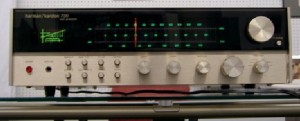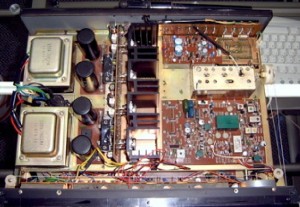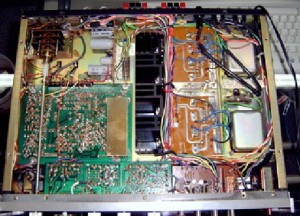Harman Kardon was founded in the early 1950’s to produce affordable, high-quality audio equipment for the average person. Their products were very well built using the best mass production techniques at the time. Unlike other companies at the time, h/k tried to keep costs down by using as much off-the-shelf componentry as possible. They then used conservative design to build affordable and excellent sounding gear. In the later 1960’s h/k began designing their products in house and sending the order to Japan or R.O.C. to have the units built. Initially, this lead to some quality control issues as certain specifications were lost in translation, and part-substitution ran amok. Marantz routinely performed on-site audits of manufacturing facilities to prevent this sort of thing from happening. h/k followed suit and enforced very stringent terms of quality control on the manufacturing facilities.
The h/k x30 series of receivers actually traces it roots back to the early 1960’s with h/k’s “Festival” series of tube integrated receivers. Starting in 1969, the line was reintroduced in solid-state form. The first “new” x30’s were the h/k 230 and 330. These were followed by the 630 and 930, and later the 430 and 730. In total, their were 10 different x30 models produced between 1969 and 1979. Power ranged between 10WPC (230) and 45WPC (930). Models numbered 430 or higher used what was to become a semi-legendary design: Twin Power.
The h/k Twin Power receivers were rather unique in that the left and right channels each had their own power transformer, rectifier circuit, and filter capacitors. This was somewhat common practice in the mid-and late 1970’s, but such a feature was only found on top-shelf integrated amps. Other companies, such as Marantz, touted “Dual Power” systems, but these were not fully twin powered like the h/k’s: these “Dual Power” designs used two secondary windings on a common transformer core, negating some of the benefits of a truly twin-power design.
The benefits of the design were numerous:
- Double the current capability
- Increased peak power
- Incredible channel separation
- High-dampening factor

The 730 was the second place unit in the second series of Twin Powered x30 receiver with the TOTL unit being the Citation Receiver (not really a x30 receiver, but was still Twin Power). The 40WPC 730 replaced the 45WPC 930 in 1976. Nobody really missed the extra 5 watts, as dynamic power and s/n ratio increased dramatically. The Harman/Kardon 730 was also more reliable, using a simpler design and more modern components.
The power amplifier is a direct coupled (DC) complementary design (h/k’s first). It is a very low NFB design, which does not have as much ultimate gain, but it ensures greater power reserves and lower noise. The amplifiers are nominally rated at 40WPC, but using modern measurement methods, I found it was capable of 90 watt dynamic peaks (+3.25 dB), and the amplifier output is fairly stable to 2-ohms. Being a DC amplifier, however, it is more sensitive to varying loads than something like the CC Marantz 2230 or h/k 820. h/k’s claim for the frequency response (4Hz – 130kHz) seems to hold true with test loads. THD is less than 0.1% and is primarily second order. This is quite good for a 1970’s amp indeed.
The pre-amp continues the very-low NFB philosophy and is a simple and elegant design. Overall, the pre-amp section is not as good as the Marantz, but it correctly relies on the power amp to carry it. Tone controls are centered at 50Hz and 10kHz, and provide +/- 12 dB gain or attenuation. The contour (loudness) control provides an additional 10dB of gain at 50Hz. A low cut filter provides -6 dB/oct attenuation of signals below 50 Hz, and a high-cut filter provides -10 dB/oct attenuation above 10kHz. You can see from these specs where h/k cut corners in the pre-amp design, reusing the same two filters for all tone-related controls. The 730 provides 4 high-level inputs (Tape 1, Tape 2, Aux 1, Aux 2), and two lowlevel RIAA equalized phono inputs. The tuner is a 4-gang hybrid design with FET front-end and crystal filtering. Tuning accuracy is spot-on and is able to pull in even remote stations clearly. The tuning indicator monitors signal noise instead of strength, which is unusual. AM performance is astounding when compared with modern receivers.
H/K receivers, especially the twin-power x30 series, are my favorite to listen to. They have a simple and understated sound that results in little or no listening fatigue even after several hours of moderately loud listening. The 730 is exceptional in all these regards. Background noise is almost non-existent allowing for a perfect canvas onto which to “paint” music. Bass tones are always satisfying, and midrange and treble are very clear. Clipping is graceful, resulting in slightly compressed sound, but no apparent DC nasties. The 730 also demonstrates extraordinary tonal balance. The bass and treble controls are virtually unneeded the sound from the amplifiers is naturally so full and well balanced.
All of this results in one of the most enjoyable and musical receivers ever made. Truly a classic.
from affordableaudio, By Michael Jarve




Spot on review, I thought my 330c was amazing till I got my hands on a ‘730 twin’. Big, Rich and Dynamic! Someday I’ll dive inside and get the bulbs replaced, all but one are burned out and she deserves to look as good as she sounds.
I bought mine when first they were sold. I still listen to it every day. It was a delight then and it is a delight now.
I was born the year the 930 come out never paid any attention to hk stuff then in a thrift store one day i paid $30 for a hk 930 i was blown away when i compared it to my yamaha cr3020 well so i went and had the cr3020 recapped the hk still sounded better and still plays fine with all original caps well i sold the cr3020 and now collect hk gear i love it
bought my 730 in 1976 with my first marine corp pay check from the PX(base store) for around $200.00 best investment ever,it seems to sound better every time I crank it up. CD’s and XM radio which didn’t exit back then sound’s crisp and clean. Still Loving It.
I love my 730 with its Tuners quality and Audio sound quality. It goes very well with my Speakers MISSION 782
I have a 1976 720 that my father bought that year. I remember it had incredible sound through it’s original speakers in the late 80’s still. Speakers that blew before the 90’s now long gone. I plan to use this for monitoring in the studio. I am quite sure it will do a good job. My thinking is that studio monitors are too clear. You aren’t going to be listening to the CD or Vinyl through high power ultra high sound reproducing monitors. Why use them when this thing will likely give a better simulation of what the final product is really sounding like over a quite powerful receiver like this old thing. Still solid state but, as I remember the sound quality it was very warm and rich with great bass thump. I must look up what speakers to get that will do it justice.
Although they are both great, I prefer the 930 over the 730. Mine is one of three I have owned over the years and some 730’s. the 930 is best receiver ever except for the HK Citation receiver (limited to about 750 units produced) and the Luxman R1070 another great receiver. Overall, the 930 is outstanding in every way.
My mother bought a 730 twin in 1979 and it sounds every bit good now (in my living room) as it did back then blasting my kiss Alive album through it and a Pair of AR-11 speakers – A truly great sounding classic!
I have 3 or them ( 330 , 430, 730)
Beautiful sound with akai tuner ( 55o) and cd Missio ( Pcm 7000 +dac5)
Listening now a Préfab Sprout with the preamp citation 11 and speakers DAvis Sinphonia
Holaaaaa ….!
Petit mot de Bretagne (France)
Kenavo
My 730 paired with my ADC soundshaper, chrome audio, and my rare Krest speakers and Polk sub, can be heard crystal clear and felt for blocks away.
Reremember the old Memorex commercial where the guy sat in the chair and he turned on the speaker and his hair blew backwards that’s how it feels every time I sit in front of my stereo.
There are better pictures then that first one, that isn’t even the stock volume control.
I have had receivers come and go. But the HK 730 is still my main receiver. It’s just a really solid performer that has great synergy with other speakers. The funny thing is that you can get one for just about nothing. Great, warm sounding classic!